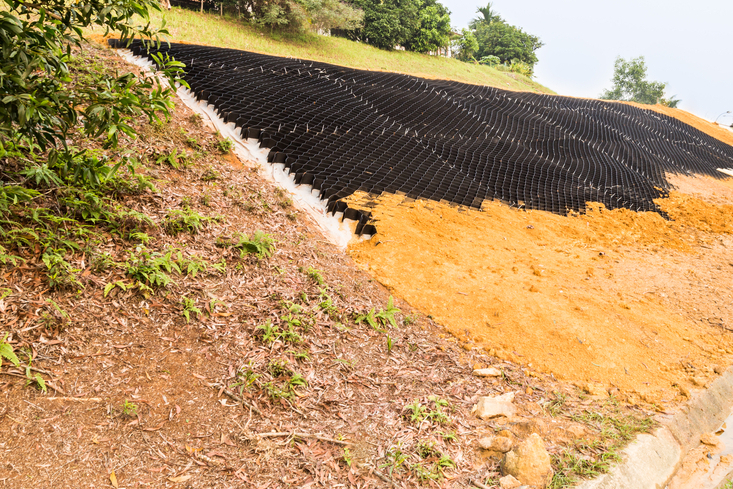Silt Fences: Your First Line of Protection Versus Erosion
Wiki Article
Best Practices for Erosion Control in Building Projects
Are you working with a building job and worried regarding erosion control? Look no more! In this write-up, we will certainly lead you with the most effective methods for protecting against erosion on your site. You'll discover five necessary techniques, efficient debris and runoff management strategies, crucial factors to consider for incline stabilization, and tips for protecting plant life and dirt. We'll also look into the significance of carrying out correct drainage systems. Prepare yourself to take on disintegration head-on and make sure the success of your building and construction project.5 Crucial Erosion Control Strategies

To properly control erosion on your building and construction website, you'll require to implement necessary techniques such as slope stabilization and sediment control procedures. Incline stabilization is crucial in protecting against soil erosion on steep slopes. An additional reliable method is the use of erosion control coverings or floor coverings, which are placed on the incline and help preserve soil particles while enabling plant life to grow.
Effective Debris and Drainage Management

You can efficiently handle sediment and runoff in your building and construction project by executing correct erosion control measures. Another vital technique is the implementation of erosion control blankets or mats. By implementing these erosion control measures, you can effectively handle sediment and runoff in your construction project, decreasing the effect on the environment and complying with governing requirements.
Trick Factors To Consider for Slope Stabilization
You need to very carefully analyze the incline's qualities, such as its angle, structure, and drain patterns. Look for indicators of erosion, such as exposed roots, fractures, or down soil.As soon as you have identified the unpredictable areas, you can start applying steps to maintain the slope. One typical technique is the usage of keeping wall surfaces or terracing to produce a collection of flat steps, which can help disperse the weight and avoid additional erosion. Another option is to grow greenery on the slope, as the origins can aid secure the soil and control disintegration. Furthermore, setting up disintegration control blankets or mats can provide immediate defense while greenery ends up being recognized.
It's important to frequently monitor the maintained slopes to ensure their efficiency. Watch out for any kind of signs of movement or disintegration, and take instant activity if required. Routine upkeep, such as inspecting and repairing any type of broken measures, is additionally vital to make certain lasting security.
Ideal Practices for Greenery and Dirt Security
One reliable method to shield vegetation and soil on slopes is by regularly inspecting for indicators of disintegration and taking immediate activity if necessary. Begin by inspecting the slope for any type of indications of erosion, such as revealed roots, bare soil patches, or debris build-up at the bottom. anonymous Implement disintegration control actions such as installing disintegration control coverings, mulching, or even constructing retaining walls if required.Carrying Out Appropriate Drainage Solutions
When it comes to handling water circulation and preventing disintegration, recognizing these aspects is vital. Steeper slopes can lead to quicker water circulation, increasing the threat of disintegration and flooding. On the various other hand, gentler slopes permit water to move much more slowly, reducing erosion capacity.Dirt kind also affects drainage system layout. Different dirt kinds have differing levels of leaks in the structure, impacting just how water is taken in and drained. Sandy soils often tend to drain pipes small landscape design faster due to their coarse structure, while clay dirts have a slower water drainage rate due to their small nature. Understanding the dirt kind aids in selecting suitable water drainage techniques, such as utilizing absorptive materials or setting up French drains. In addition, taking into consideration the dirt features aids avoid waterlogging, which can result in poor plant growth and damages to frameworks.
Conclusion
In final thought, when it pertains to disintegration control in construction tasks, you should adhere to these best methods. Execute effective sediment and runoff management techniques to avoid contamination. Think about slope stabilization techniques to guarantee the security of the website. Protect greenery and soil by using proper steps. Last but not least, establish proper water drainage go to my site systems to take care of water flow. By adhering to these important methods, you can successfully manage erosion and ensure the success of your building and construction job.To effectively control disintegration on your building site, you'll need to carry out necessary strategies such as slope stabilization and debris control actions. Incline stablizing is crucial in protecting against soil erosion on high slopes. Another reliable method is the use of erosion control coverings or mats, which are placed on the incline and help keep soil bits while allowing greenery to expand. One more choice is to plant plants on the incline, as the origins can aid secure the dirt and control erosion. Implement disintegration control actions such as setting up erosion control coverings, mulching, or even constructing retaining wall surfaces if needed.
Report this wiki page